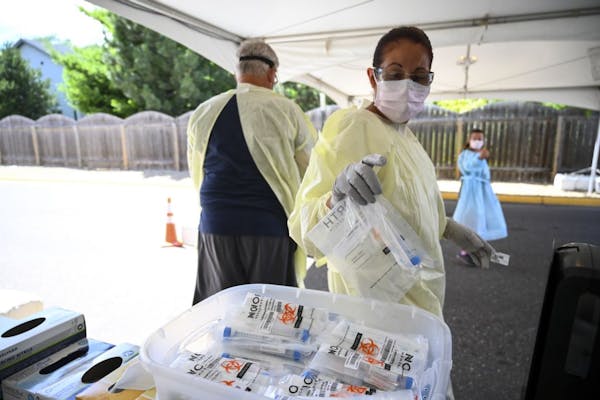Why do Minnesota coyotes howl when trains go by?
Listen and subscribe to our podcast: Via Apple Podcasts | Spotify | Stitcher
Many a Minnesotan huddled around a bonfire has whispered, "Shhh! Hear that?" as coyotes howl and yip off in the dark.
Their songs are bewitching — not so hair-raising as the deeper howls of wolves, but still, indisputably wild.
A bonfire group in Goodhue County has noticed something else — the coyote chorus often comes as a train rumbles by and sounds its horn. And in the Twin Cities, attentive listeners report hearing urban coyotes engaging in call-and-response vocalizations with sirens.
Why do they do that?
Ask four people, and they'll give you four theories: A train stirs up the small mammals coyotes hunt. They're howling because the horn hurts their ears. They think the train is a giant coyote. Or, they believe it is their god.
Time for some science.
Coyotes aren't the only canines that respond to klaxons. Wolves and dogs do too.
"When these animals evolved, the only sounds of that type in their environment were their compatriots, so there was no need to distinguish between compatriots and other sounds," wolf researcher Dave Mech said in an e-mail. "In short, they simply think the fire siren is another wolf howling."
But it's more complicated than that. Stanley Gehrt, an Ohio researcher who has extensively studied urban coyotes, said it helps to understand why they vocalize at all. "Coyotes are a pack animal, but they spend so much time foraging or hunting in pairs, they need to be able to come together to maintain their social bond, so vocalization serves as a gathering point," he said. Also, the hyperterritorial animals howl "to communicate to all of their neighbors and solitary coyotes that this place is occupied."
Knowing all that, Gehrt and fellow researchers discovered "purely by accident" why whistles and sirens are such strong triggers. While studying the nuances of coyote vocalizations, "to get them to howl, we'd play sirens, because we knew it was impossible for them to resist," he said. "The beginning of the recording always started with a siren, and just by chance, we noticed on the sonogram that the main pulse in the frequency range of the siren was exactly the same as the pulse of their calls."
Although wolves and coyotes are much honored by Minnesota's Ojibwe and Dakota people, horns and sirens are too modern to have made their way into passed-down stories.
Thomas Peacock, author of "The Wolf's Trail: An Ojibwe Story, Told by Wolves," says he often hears coyotes and wolves howling near his northern Minnesota home, and occasionally "gets them going by howling ourselves."
In short, coyotes, wily as they are, can still be fooled by a human howling, and believe a whistle or siren is "a big bad coyote in the middle of their territory," Gehrt said.
Coyotes are here to stay, and no amount of (perfectly legal) hunting will eradicate them. When a coyote population is decimated, they recruit solitary animals and increase their litter sizes to fill the void.
"Coyotes and crows will be here when we're gone," an old uncle of mine used to say. And when, around that bonfire, you hear the midnight special's lonesome whistle and the song dogs' spooky response, you'll be glad of that.
---
If you'd like to submit a Curious Minnesota question, fill out the form below:
Read more Curious Minnesota stories:
Why do wild turkeys seem to thrive in the Twin Cities Corn dog vs. Pronto Pup: Why are Minnesotans so loyal to only one?
Why is Minnesota the last state with 3.2 beer?
What's the story behind the names of Pilot Knob, Johnny Cake Ridge and Yankee Doogle roads?
Why is recreational marijuana not legal in Minnesota? After Lake Calhoun, what about other place names with racist roots? Why is Minnesota more liberal than its neighboring states?
When you flush a toilet in the Twin Cities, where does everything go?
Was Minnesota home to nuclear missiles during the Cold War?


